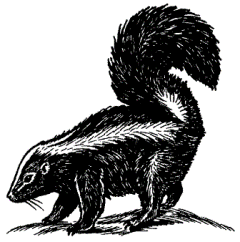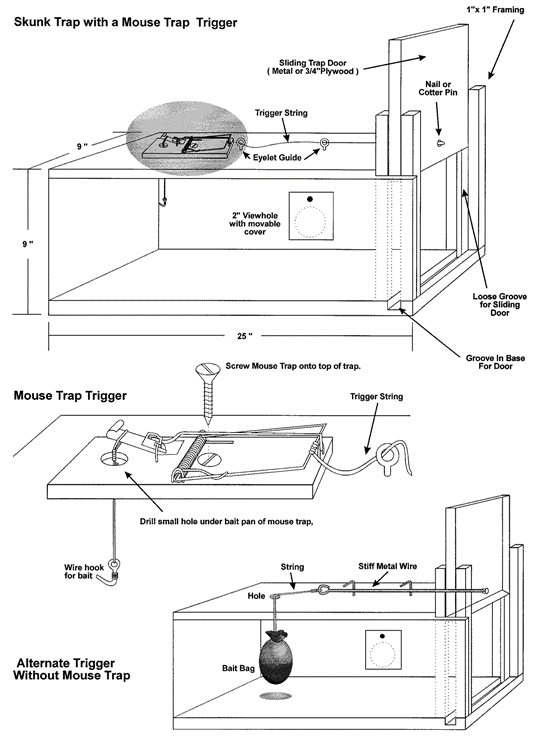
When Skunks Become a Nuisance
| by Mark Pulsifer |
Most Nova Scotians are familiar with the eastern striped skunk ( Mephitis mephitis ). It is easily recognized by its long, black fur, its long, bushy tail, and the two prominent white strips that run along its back. Males and females look alike, but males are usually larger, about the size of an adult house cat.
Skunks are a valuable wildlife resource and are generally beneficial to farmers, gardeners, and landowners because they consume a large number of small rodents and insects. The handling of problem skunk situations should be preventive. Control is necessary only when individual skunks become a problem or cause economic losses.
 Skunk populations fluctuate regularly. They disappeared from most of Nova Scotia during the 1920s and 1930s, likely because of a distemper epidemic. Since then, striped skunks have repopulated much of mainland Nova Scotia. There are no skunks on Cape Breton Island.
Skunk populations fluctuate regularly. They disappeared from most of Nova Scotia during the 1920s and 1930s, likely because of a distemper epidemic. Since then, striped skunks have repopulated much of mainland Nova Scotia. There are no skunks on Cape Breton Island.
Striped skunks are best known for the highly repellant musk they produce to defend themselves. When a skunk decides to spray, it raises its tail and expels a fine spray from its anal glands up to five metres. Those unfortunate enough to be sprayed in the eyes experience intense burning and excessive tear flow, and may be temporarily blinded.
Adult skunks have the capacity to release more than one discharge. Young skunks are capable of emitting musk as early as seven weeks of age. Despite what some people may believe, a skunk can release its musk if its hind feet are off the ground.
They also spray their musk to mark their territory, which may give away their presence. Skunks are most often found near mixed woodlands interspersed with meadows or agricultural lands. Although primarily active at night, skunks are occasionally seen at dawn or dusk or even during the day.
Skunks eat a wide variety of foods. They feed at night, exploring forest edges, meadows, marshes, ditches, stream banks, and lawns for small rodents, insects, reptiles, amphibians, carrion, grubs, fruits, and vegetables. Skunks have also been known to eat the eggs and nestlings of ground nesting birds.Skunks generally spend their daylight hours asleep in underground burrows. These burrows often come from other animals such as ground hogs. If necessary, skunks will excavate their own burrow, but more often they enlarge an existing hole in a rock pile or under a stump or building. One burrow is usually used for shelter and raising young.
In winter it is not uncommon for several adult females and young to share a burrow. Adult males often den alone.Although skunks are not true hibernators, they do go into a deep sleep in late fall or early winter, awakening only during winter thaws or periods of warmer weather to forage and mate.
In Nova Scotia, skunks become active in late February. Mating occurs in February or March. After mating, males remain solitary until fall. After 62 to 63 days, four to seven young are born blind and helpless. Young are weaned after seven weeks, at which time they are taught to hunt by the mother. Young skunks generally disperse during the fall of their first year, but may remain with their mother through their first winter. Both male and female skunks are sexually mature by February of their first winter.
Legal Status
Striped skunks are designated under the provincial Wildlife Act as "other harvestable wildlife". For the purpose of preventing damage to property, skunks may be taken or killed without a license or permit, at any time of the year by the owner/occupier of the property or an agent of the owner/occupier. It is illegal to use poison to kill skunks.
Skunks are also classed as furbearers and may be taken by licensed fur harvesters during the appropriate season.
Damage Identification
Skunks become a nuisance when their burrowing, feeding, and defence habits conflict with man. One common complaint is that skunks get into basements, garages, and barns, under porches and mobile homes. Skunks often burrow under buildings where they can gain access. Although skunks rarely spray in their own burrow, the first indication a skunk is nearby is often a persistent musky smell centered around a particular building or natural shelter. Further investigation may reveal a single burrow entrance.
Skunks are especially fond of insects. In spring, skunks often dig small pits in lawns, golf courses, and gardens looking for grubs or larvae. These diggings appear as small, 8 to 10 cm conical holes or patches of upturned earth and turf. Periodically, skunks may destroy or disrupt bee hives in search of bees or their larvae. They are apparently not discouraged by bee stings. Skunks have also been known to kill poultry and to eat eggs.
On occasion, skunks fall into window wells, post holes, or other pits and become a problem, both for the skunk and the property owner. Skunks are notoriously poor climbers and have to rely on some form of human intervention to escape these predicaments.
Prevention Techniques
In many cases skunks are attracted to yards and buildings because of the availability of uneaten pet foods and garbage in uncovered containers. Pet foods should not be left lying about, particularly after dark, and all garbage should be enclosed in containers with tight fitting lids.
If skunk damage to lawns and gardens becomes intolerable, the best preventative measure is to rid the lawn or garden of the insect pest. Garden supply centers or landscapers may be able to recommend a suitable pesticide.
Problem skunks can sometimes be discouraged from entering an area illuminated by bright lights of flood lights.
The best way to control skunks around buildings is to prevent access. Crawl spaces under buildings or porches should be covered with metal screening, sheet metal, or wood. Skirts around mobile homes should be well sealed and maintained. If suspected denning places are to be sealed off between May and mid-August, caution should be used to avoid trapping young animals inside. If skunk activity is suspected, sprinkle flour or ground limestone near the opening and then check for tracks after dark. If tracks lead out of the den, then this opening can be sealed off.
Skunks are very poor climbers and proper fencing will usually exclude them. A one-metre high fence made from poultry wire, with part of the mesh buried in an outward "L" shape below the ground, will keep skunks out.
Skunks that wander into cellars, garages, or barns should be allowed to leave on their own. An open door or a rough plank leading up to an opening is generally all the invitation a skunk will need to leave.
Mothballs, naphthalene crystals, or ammonia soaked rags may be used to temporarily discourage skunks from using a burrow or to discourage use of a particular area before someone can close off the entrance. Caution: when using these compounds, avoid contact with eyes, do not inhale fumes, and wash hands after use.
Bee keepers will find the best method of keeping skunks away from their hives is to place the hives on one metre high platforms. Alternatively, an electric fence placed 12.5 cm above the ground will keep skunks out.
Removal
In some cases, the use of chemical deterrents or exclusion techniques may not be practical or possible. In these cases, live trapping may be the most practical answer. Licensed nuisance wildlife operators are found throughout Nova Scotia and, for a fee, will get rid of nuisance wildlife.
Individuals may also purchase a live trap from most hardware stores and trap the skunk themselves or construct one for relatively little cost (see plans for live trap ). Wooden box traps or wire mesh traps can be baited with cat food, chicken scraps, or fish and left near the burrow or area suspected of harboring a skunk. To reduce the chances of catching a cat, use bread and peanut butter.
Cover wire mesh traps, except for the entrance, with a burlap bag or opaque plastic. If a skunk is captured, it can safely be removed to a distant place away from the potential problem areas without fear of being sprayed. Remember to check your traps regularly, especially first thing in the morning. Handle the trap and its contents gently and keep it away from dogs and curious people.

Use of other types of traps may be practical for catching skunks, but require a permit from the Department of Natural Resources and Renewables.
In areas where firearms may be legally discharged, shooting with a shotgun can be effective under the right circumstances, but will most likely result in the release of spray. Anyone considering this method should inquire about firearms regulations in their area. Use of other types of firearms usually requires a permit from the Department of Natural Resources and Renewables.
Disease
Skunks are host to a number of parasites and diseases that are of concern to humans and domestic animals. Distemper can be common and there is also the potential for rabies. Diseased skunks can sometimes be identified by behavior that is thought to be abnormal for the species, such as daylight wanderings, uncoordinated movements, and unwarranted aggression. Diseased animals may also suffer from convulsions, spasms, and discharges from the eyes and nose. Obviously sick animals should be dispatched humanely, as soon as possible, and immediately reported to the Department of Natural Resources and Renewables.
Scent Removal
Diluted solutions of tomato juice or vinegar are reputed to be effective in educing the odour of musk from people, pets, and clothing. Commercial products specially designed to remove skunk odour may be available from local veterinarians. Neutroleum Alpha, an aromatic deodorant, is effective when applied to cotton balls and placed in basements or garages. This material can be purchased from most hospital supply houses or pest control agencies.

Please contact your local Department of Natural Resources and Renewables office for additional information.